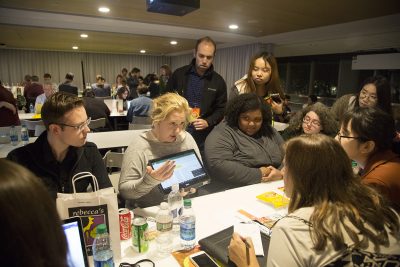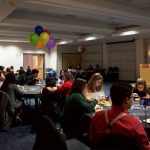
Trading in pitches for data sets, journalists and data lovers alike came together to trade skill sets and share tips during HUBweek’s first annual “Data Science, Journalism, and the Future of Justice” Hackathon Wednesday. Over 150 undergraduates and professionals filled Northeastern University’s John A. and Marcia E. Curry Student Center, all eager to learn about the new ways that data can be used in the journalism field.
The hackathon was hosted by John Wihbey, a journalism and new media professor at Northeastern University; Todd Wallack, an investigative reporter with The Boston Globe’s Spotlight team; Dan O’Brien, a professor at Northeastern’s School of Public Policy and Urban Affairs and research director of the Boston Area Research Initiative; and Professor Michelle Borkin, a computer scientist and data visualization expert at Northeastern’s College of Computer and Information Science.
“Since I’ve been in journalism, I’ve seen huge change in data journalism, and more and more emphasis on it,” Wallack said during the panel session.
With a field as dynamic and evolving as journalism, the organizers explained that both conversion and innovation were key.
“It’s really key for journalism schools and people in news rooms to think about all the possibilities with the explosion of data,” Wihbey said, referring to the increase in data availability online.
To help both expert and beginner coders understand how data analysis can be applied to journalism, the organizers let them get hands-on with local data.
“You see journalists start to use some of the tools, like programming languages and visualization practices, that people are using in the social sciences and other industries that are doing data,” Wihbey said. “So there is the beginning [of] a conversion.”
Participants were put into groups and given large data sets about criminal justice in the City of Boston, such as Field Interrogation and Observation. These data sets included crime incident reports as well as stop-and-frisk procedures.
The task at hand was to look for patterns or correlations that might pique journalistic interest, thus finding a story within the numbers.
Wallack expressed the significance of this data.
“I’m really excited that you’ll be talking about criminal justice data because it’s so important,” Wallack said. “It has such a big effect on people’s lives.”
Abigail Skelton, a 23-year-old journalism graduate student and the student services and data manager at Northeastern, led a team of her classmates in looking for bias in FIO. During this process, Skelton experienced first-hand the “conversion” between industries that Wihbey mentioned.
“I’ve learned that I can use the skills I have in analyzing data across a lot of different disciplines,” Skelton said. “I learned to analyze data mainly in statistical analysis of political power structures in East African and West African nations, which has nothing at all to do with crime rates in Boston, but the methods you use are the same.”
However, it is not just journalists who look to make this conversion to a more data-centric world. It’s also the readers.
“It’s changed a lot where readers expect to not only see numbers in a story, but actually see the data,” Wallack said.
Because of this, professors like Wihbey are encouraging their students to explore data journalism, but without taking away from the importance of still going out and reporting. It is not a question of choosing which field, but instead integrating the two subjects, in true HUBweek fashion.
While journalists remain the connection between information and the public, Wihbey also noted that being data-aware naturally fits into this role.
“I think journalists need to become real watchdogs and skeptics of claims that are based on data,” Wihbey said. “There are many examples of data that seem to tell a certain story when in fact the truth is obscured. So we need to ask hard questions about how data is collected. There are more opportunities for journalists to dig in to numbers.”
The push to tell stories is what what separates data journalism from more quantitative fields like financial services or healthcare analytics, according to Wihbey.
“We tell stories,” he said, “and we need to connect numbers to issues of public interest.”














